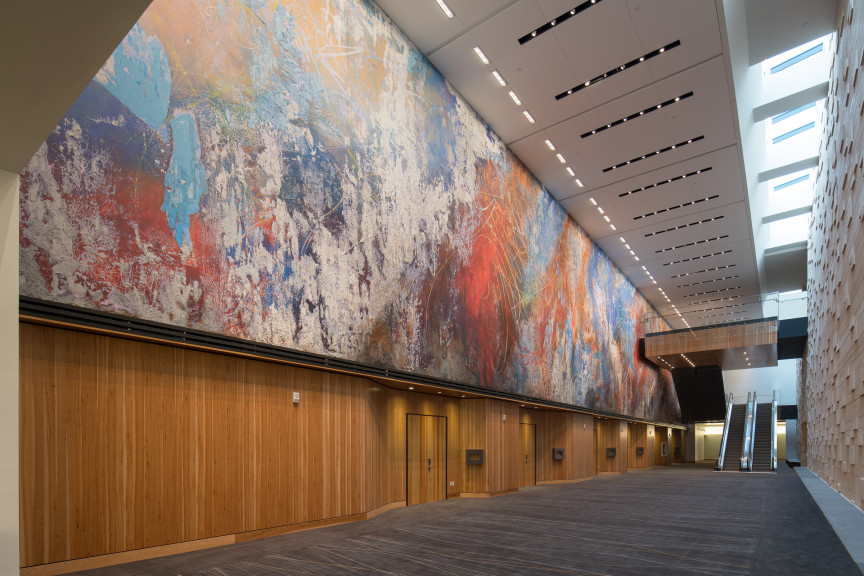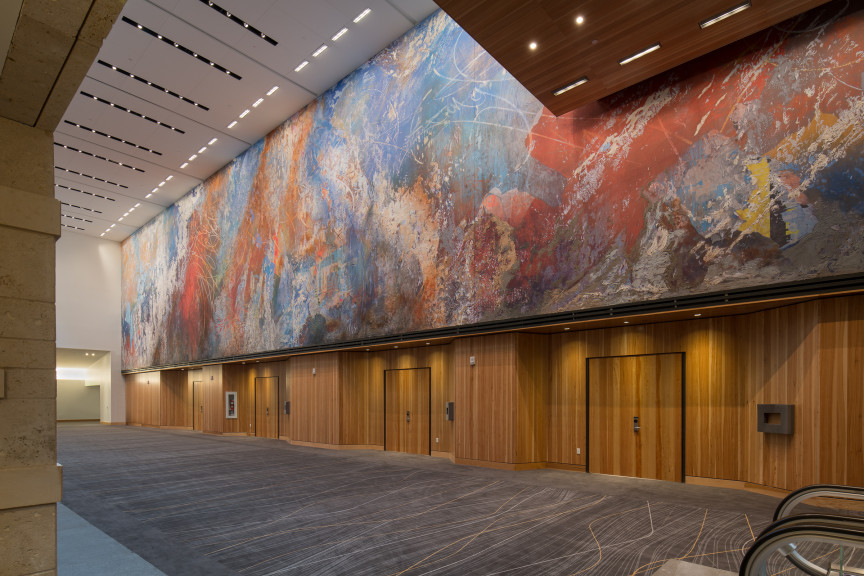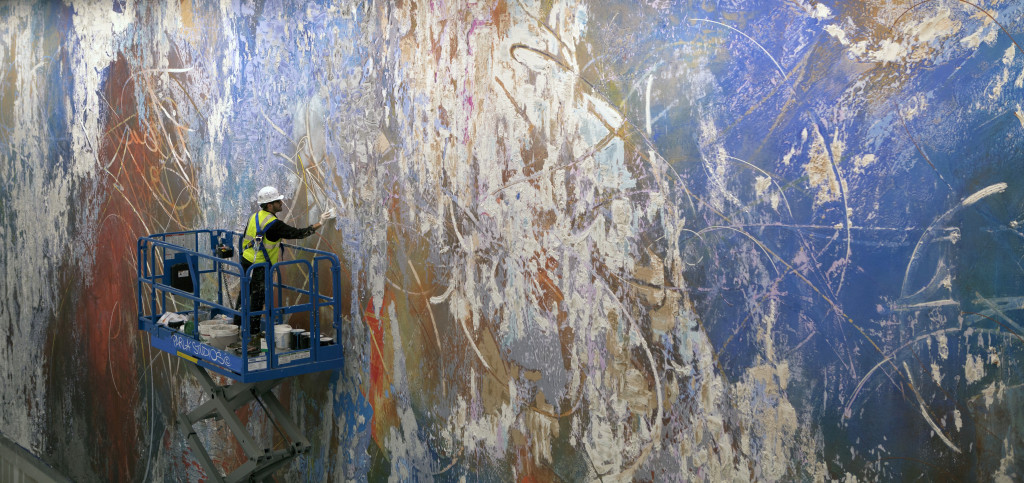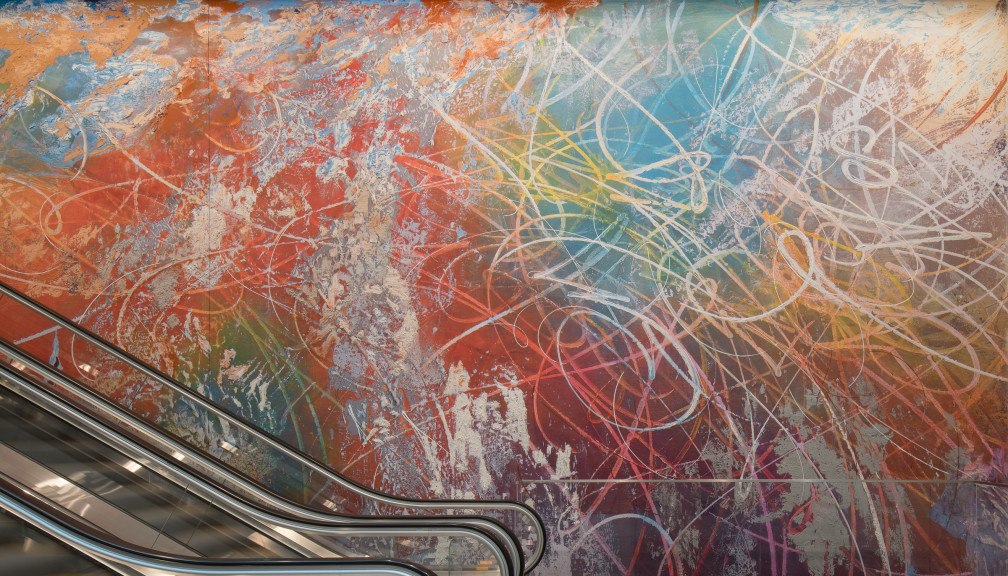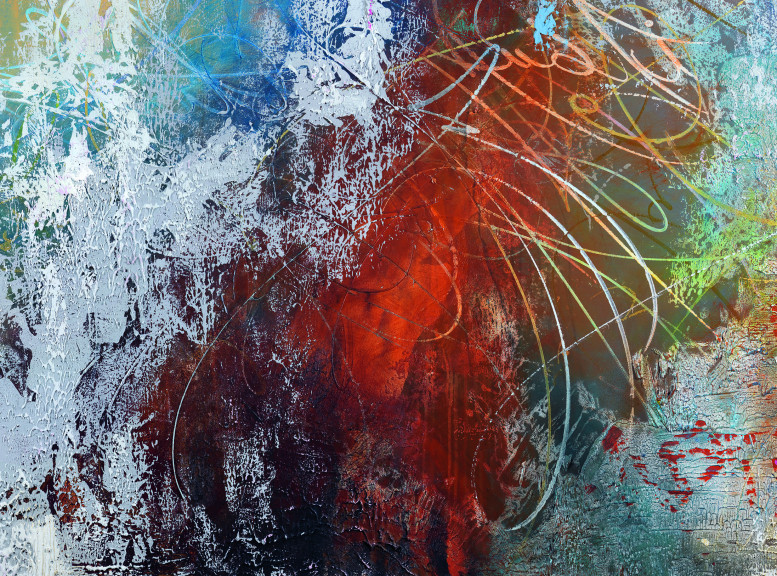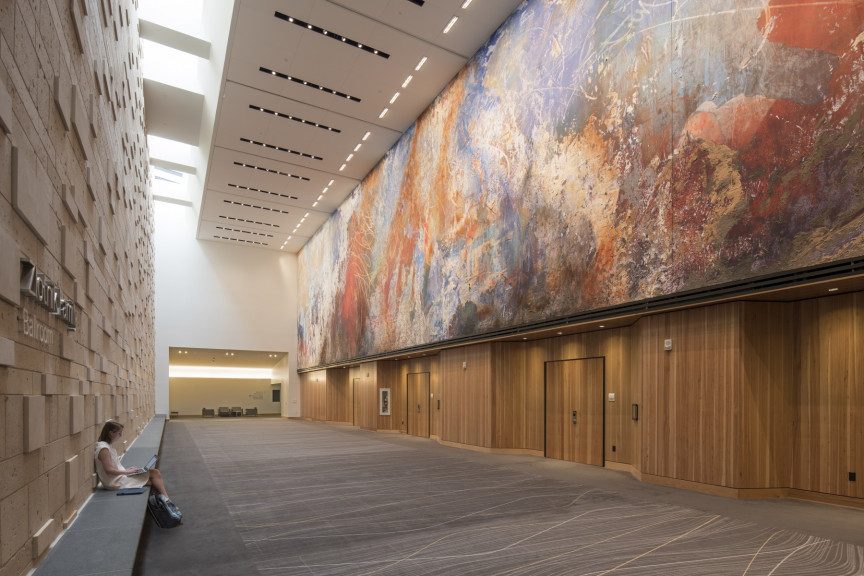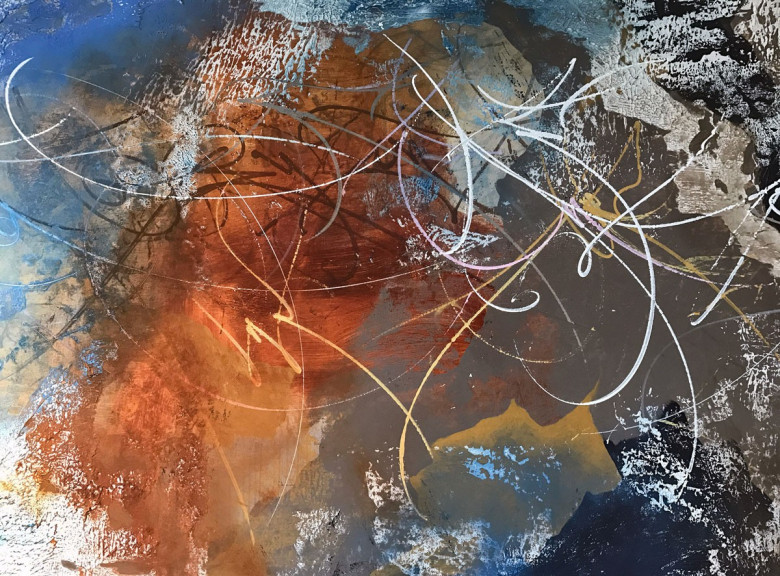Amistad América
José Parlá
304 x 1947 3/4 in.
Commission, Landmarks, The University of Texas at Austin, 2018
GPS: 30.282218, -97.741398
Multimedia artist José Parlá finds inspiration in the history and experience of urban environments. His work is characterized by exuberant compositions featuring multilayered, viscous surfaces with dense pigments and overlapping calligraphic arcs. Amistad América is composed of these elements with a scale and metaphoric complexity that is unprecedented.
Parlá began painting as an adolescent, experimenting with graffiti and learning lessons that would inform his mature artistic practice. In addition to mastering the technical agility and sheer speed required for clandestine street painting, Parlá also developed an appreciation for the rigor of physical performance, and an awareness that his body could translate the rhythms of music into visual expressions. Equally significant, he acquired a lifelong affinity for walls: as substrates for painting, as witnesses to history, and as cultural metaphors. In their scarred and decayed surfaces, he perceives humanity’s innate drive to make marks, connecting primeval cave paintings to contemporary urban scrawls.
Amistad América renders Austin through Parlá’s eyes, with a palette that evokes its vast skies, abundant nature, and pulsing urban core. The painting suggests a continental map that connects Austin to a broader ecology. It also contains obscured fragments of calligraphic letters that form the words Austin, Guadalupe, and King. These not only locate the mural physically at the intersection of Austin’s Guadalupe Street and Martin Luther King Jr. Boulevard, but they also symbolically acknowledge the work’s position at a place of Latinx and African American history and culture.
The painting offers a sweeping visual landscape that conjures Austin itself while situating the city within the larger geopolitics of the Americas. The title underscores that connection: La Amistad was a nineteenth-century Spanish trading ship that plied the Caribbean. Its African slave cargo famously mutinied in 1839 to reclaim their freedom. Parlá chose the title both to commemorate this turbulent history and to celebrate its conciliatory and optimistic resonance: from Spanish, Amistad América translates to Friendship America.
Learning at Home with Landmarks
Bring the Landmarks collection into your home-learning environment. Check out how you can engage with this work by browsing the learning resources featured on this page:
- View Photo Gallery – Click on the arrows on the sides of the image above to to view images of the work. Spend time on each photo and examine details carefully as if you were with the work in person.
- Play Audio Guide - Select “Play Audio Guide” in the upper right corner to hear a short audio guide about the art and gain a deeper understanding of its meaning.
- View Videos – Select “View Videos” to watch a 3-minute video with the artist and to understand their process.
- Activity Guides - Choose the activity guide below best suited for young learners in your home.
Still have questions or want to share your Learning at Home with Landmarks experience with us? Keep the conversation going by tagging Landmarks on social media.
ACTIVITY GUIDES
Amistad América
José Parlá
Subject: Texture and pattern
Activity: Make a finger painting using unusual materials
Materials: Paper, paint palette or paper plates, tempera paint, paint-safe toys and scrap materials, plastic sheet, and tape
Vocabulary: Pattern, shape, texture
The artist who painted this mural is inspired by busy cities like Austin. He likes to watch the ashing lights, hear the honking horns, and see people as he explores the city. The artist used bright paints, torn papers, and sharp tools to create a mural as busy as Austin!
Do you recognize any shapes in the mural?
What materials do you think the artist used?
What sort of tools did the artist use?
Do you see any patterns?
Place a plastic sheet on a table, or sidewalk, to protect it from painted fingers! Pour pools of paint on a palette or paper plates. Tape down your sheet of paper so it does not slide around. Dip your fingers in the paint and smear it on the paper. Can you draw shapes with your fingers? Tap the paper with painted fingers to create texture. Smear the colors together to make a new shade. Can you make orange from yellow and red?
Need some inspiration?
Create different textures in your painting by using disposable or easily washable tools around your house: a paper towel roll wrapped with rubber bands; spoons or spatulas; Bubble Wrap; bath toys with spinning parts or wheels; or sequins.
Create designs with tape or large stickers on your clean paper. Finger paint over the tape. When the paint dries remove the tape to see your design!
For even more fun, finger paint on the outside of old boxes and build your own city full of art!
Pattern - A repeating line, shape, or color
Space - A circle, square, triangle, or any other type of form
Texture - When something looks rough or smooth
Amistad América
José Parlá
Subject: Line and pattern
Activity: Scratchboard drawings
Materials: Scratchboard (or make your own!); tools to scratch the surface, like pencils, pens, toothpicks, spoons, or forks
Vocabulary: Line, pattern, texture
People who live in big cities use posters and walls to promote community events, advertise their business, or leave their mark in graffiti. The history of a city and the people who live there can be seen in the many layers on the walls. José Parlá is inspired by the walls and posters he sees in big cities like Austin. This mural was created by laying paint and collaging posters onto the wall. To create some of the textures, the artist scratched into paint.
What tools do you think the artist used to make this mural?
Do you see a repeating line or texture?
How is this similar to graffiti art you’ve seen outside?
Make your own scratchboard by taking a thick piece of card stock or poster board and coloring it with crayons or makers. When finished, brush a thin layer of black paint over the colors. A tip: mixing dish soap with the black paint makes it go on smoother and chip less.
Use the pointed tools to scratch a drawing into your scratchboard. Think of new ways to draw lines and create texture. What textures can you make with unusual tools like a spoon? Can you create a 3D version of your name?
Can you recreate some of the lines and textures from the mural on your scratchboard?
Line - A straight or curved mark made with a drawing tool
Pattern - A repeating line, shape, or color
Texture - A rough or smooth look to the surface
Amistad América
José Parlá
Subject: Collage
Activity: Create a word collage
Materials: Magazines, paper, scissors, glue, crayons, or markers
Vocabulary: Collage, symbolism, abstract
José Parlá is inspired by busy cities like New York, Miami, and Austin. He creates large, abstract collages that look like billboards with years and years of advertisements pasted and torn away. Parlá’s work symbolizes the generations of people who lived before him and created the spaces around him. This mural is his largest yet at more than 25 feet tall and 160 feet wide. It is inspired by Austin.
How does the artist use language in this mural?
When you walk through Austin what kind of letters and markings do you see?
What does it tell you about the neighborhood or the people who live there?
Can you see evidence of different languages and cultures?
Make a personal statement collage using scraps from magazines. Tear out letters, words, phrases, or symbols and glue them to a sheet of paper. Use markers, crayons, or pencils to incorporate the pieces into one, cohesive composition.
Can you see smaller compositions within the larger mural? Why do you think the artist chose to design the mural in this way?
Collage - A work of art created by layering paper or other objects onto a sheet of paper of canvas
Symbolism - When an artist uses an object to represent someone or something
Abstract - A work of art that doesn’t represent or look like a person, place, or thing
MORE INFORMATION
Amistad América represents the height of José Parlá’s magnitude as a painter, extending an impressive oeuvre of drawings, murals, canvases, photographs, prints, and sculptures created by the artist over more than three decades. Presented in the heart of a thriving academic environment, the mural instills a sense of wonder with its sheer scale and force. Its physical presence allures thousands of visitors each day and intrigues us with metaphoric complexity.
As one enters the Zlotnik Ballroom from the underground passage to Robert B. Rowling Hall, the painting rests on the horizon in a swirl of aqua, umber, and salmon hues. Its position resembles that of a cinematic screen made luminous by the contrasting surrounds. Vibrating patterns fill the frame of the corridor and draw us forward, growing larger as their textures come into focus. Parlá’s staging unfolds dramatically once we cross the threshold onto the landing; as our eyes follow the painting to its farthest corners, we realize that our initial view was a mere sliver of the whole.
Inside the ballroom entry, Amistad América envelops us in four thousand square feet of painting. From the mezzanine we can see viscous surfaces that were shaped by the pressing of Parlá’s hand. The ground level below offers a contrasting perspective in which the mural climbs to four stories and its details dissolve in the distance. At no vantage can the entire work be seen at once; our gaze switches between the intimate and the grand. Perhaps our eyes rest upon a collaged fragment lifted from city walls, or upon trails of pigments conceded to the weight of gravity. Taken together all passages cohere in an overarching rhythm—a compositional feat that would daunt most painters.
Even for Parlá, the soaring scale of Amistad América is unprecedented. It emerges from a lifetime of discovery that began at a tender age. A child of Miami, with its brilliant skies and saturated hues, Parlá learned the rituals of street culture in the camaraderie of fellow writers. He developed an enduring affinity for walls both as substrate and metaphor, and he established a signature script that would evolve into sweeping masses of calligraphic arcs. Years of painting in the city conditioned him to respond reflexively to the scale of urban architecture, while the perils of clandestine work trained him to make decisive gestures with impressive velocity. Above all, Parlá’s early forays taught him the rewards of taking risks and the satisfactions of asserting his mark in the landscape.
As his artistic practice matured, Parlá shaped these formative influences into a distinctive visual style that is evident in Amistad América. The work of abstract masters such as Cy Twombly and Clyfford Still provided inspiration for his expressive improvisations. Distinguishing him from these artists are the ways in which Parlá merges more familiar painterly elements with his longstanding interest in the neglected aspects of urban existence. He embraces the grit and decay of the city by applying layering techniques that appear time-worn and weathered, working fragments of posters and other detritus into his surfaces directly. In doing so he introduces a new vocabulary that powerfully juxtaposes a formal lyricism with a raw edge—a tension that results in work that is eminently of our time.
Parlá has also defined a vast conceptual territory for himself that weaves his interests in social and political history together with his impressions of people, places, and memory. His experimentation with methods and forms has evolved into a manner of painting that is highly personalized and readily recognizable. As his stature has grown his large-scale projects and other works have found audiences throughout the Americas, Europe, and Asia, ever expanding his opportunities to find connection and meaning. Between his technical agility and flair for the theatrical, Parlá was the ideal choice for this Landmarks commission.
The challenge to invent a new public art destination in Austin energized Parlá from the outset. During our initial meeting to review building drawings with Ennead Architects, he identified the colossal wall that would lead into the Zlotnik Ballroom and became enthralled with the idea of transforming it. The technical difficulties were formidable, from determining its support structures to engineering ways for him to access its most cavernous reaches. A whiplash schedule that accommodated the movements of six hundred construction workers on site each day called for brinksmanship. At each stage Parlá responded with characteristic assurance, determined to tease out solutions and realize his vision.
To prepare for the painting itself, Parlá first devised a modello in his Brooklyn studio. Working on a small-scale version of the mural enabled him to envision the encounter as a whole. Earlier large commissions, such as those for the Brooklyn Academy of Music and One World Trade Center, informed his thinking about the mechanics of making monumental works and their successful presentation. The artist then oversaw every aspect of the site in Austin, from materials and design to the complex lighting scheme. Within such a rigorously controlled structure, he was then free to direct all of his energy into painting.
Amistad América renders Austin through Parlá’s eyes, with a palette that evokes its vast skies, abundant nature, and pulsing urban core. However imposing the scale, his sweeping landscape is only partly explained by its physical presence. It situates the city within the larger geopolitics of the Americas, suggesting a continental map and routes that connect Austin to a much larger ecology. It also contains fragments of calligraphic lettering, including three key words partially obscured by thick masses of color: Austin, Guadalupe, and King. These not only locate the mural at the intersection of Austin’s Guadalupe Street and Martin Luther King Jr. Boulevard, but also acknowledge its symbolic position as a place of Latinx and African American history and culture.
The mural resonates too with its institutional place. The McCombs School of Business is fundamentally concerned with understanding the nature of commerce, a realm that seismically affects our environment, our culture, and our ways of being. The painting contains geographic microcosms that reveal city grids and the borders between nations, as well as the traces of industry, trade, and migration. It serves as a powerful reminder to tomorrow’s business leaders and decision makers that every choice shapes the course of our lives, the landscape we inhabit, and our shared history.
Amistad América is a monumental site-specific painting commissioned by Landmarks for The University of Texas at Austin.
In creating Amistad América, I am inspired by the natural and cultural landscape of Texas and the Americas. The Spanish translation of the state’s name, Tejas, derives from the Native American Caddoan word táy-sha, which means “friends.” In Spanish, Amistad means “friendship.”
For this project, I have continued to work with my interest in the history of migration and began by painting abstract shapes of broken wall surfaces resembling the outline of maps, and borders between nations. Calligraphic flourishes suggest our civilization’s continual struggle with migratory traces, trade, and cultural exchanges that harm the natural world and form a charged political climate.
From the Cognitive Revolution (c.70,000 BCE) when Homo-Sapiens evolved imagination to modern times, art in its endless visual forms has given us clues to how humans record, behave and perceive the meaning of our lives. Art has the power to be a tool for positive change and resistance against injustice in a world where no condition is permanent. In painting I seek abstraction and feeling as a form of communication to provoke open diplomatic conversation.
My process in this project started out by making a study in my Brooklyn studio using paint, plaster, and found ephemera. The work also incorporates transparencies of color and engraved lines that act as close-ups of city grids like the intersection of Martin Luther King Jr. Blvd and Guadalupe Street in Austin where the mural at Rowling Hall will live permanently. By acknowledging these geographical and lingual origins, my painting references the rich and turbulent cultural history of the Americas.
-- José Parlá, Brooklyn 2017
Amistad América is commissioned by Landmarks for the Robert B. Rowling Hall, McCombs School of Business – The University of Texas at Austin.
Parlá, José. Surface Body/Action Space. Bologna: Damiani, 2015. Exhibition Catalog.
Parlá, José, and Clara Astiasarán. Wrinkles of the City: Havana, Cuba. Bologna, Italy: Damiani, 2012.
Parlá, José, and Michael Betancourt. Adaptation Translation. London: Elms Lesters, 2008. Exhibition Catalog.
Parlá, José, Laurie Ann Farrell, and Storm Janse van Rensburg. José Parlá: Roots. Bologna, Italy: Damiani, 2017. Exhibition Catalog.
Parlá, José, and Jonathan Lee Fox. José Parlá: Walls, Diaries, Paintings. New York: Bryce Wolkowitz Gallery, 2011. Exhibition Catalog.
Parlá, José, and Michael Rooks. José Parlá: Segmented Realities. Atlanta: High Museum, 2015. Exhibition Catalog.
Parlá, José, Bryce Wolkowitz, Dieter Buchhart, Lara Pan, and Brian Currid. José Parlá: in medias res. Bologna, Italy: Damiani, 2014.
To watch a Q&A between José Parlá and art critic Carlo McCormick, email landmarks.utexas.edu.
Landmarks commissioned José Parlá to create a site-specific, monumental mural for the atrium of Robert B. Rowling Hall. Amistad América is Parlá’s largest mural to date and the first painting acquired by Landmarks.
Funding for the commission was provided by the capital improvement project for Robert B. Rowling Hall at the McCombs School of Business. Numerous individuals lent their support to this project and Landmarks would like to give special thanks to the following:
Leadership
Andrée Bober and Landmarks
Douglas Dempster and the College of Fine Arts
Gregory Fenves and the Office of the President
Jay Hartzell and the McCombs School of Business
Landmarks Advisory Committee
James Shackelford and Capital Planning and Construction
David Rea and the Office of Campus Planning and Facilities Management
Campus Master Planning Committee
Project Team
Nisa Barger, project manager, Landmarks
Andrée Bober, curator and director, Landmarks
Mark Brooks, Capital Planning and Construction
Coburn & Company
DPR Construction
Duggal Visual Solutions
Ennead Architects
Jacobs Engineering
José Parlá, artist
Rey Parlá, Parlá Studios
Vault Fine Art Services
Catherine Williams, Silver Lining Art Conservation
Eldon Wood, Project Management and Construction Services
Special Thanks
Alison Berg, AT&T Hotel and Conference Center
Susie Brown, McCombs School of Business
Christine Burdell, McCombs School of Business
Sarah Canright, Department of Art and Art History
Holland Chaney, intern, Landmarks
Pat Clubb, former Vice President for University Operations
Deb Duval, event coordinator
Thomas Gilligan, former Dean of McCombs School of Business
Eric Hirst, McCombs School of Business
Carlo McCormick, curatorial contributor
Chris Mendoza, Parlá Studios
Jeff Melton, McCombs School of Business
Ted Hibler, AT&T Hotel and Conference Center
Emmy Laursen, communications, Landmarks
Jennalie Lyons, development, Landmarks
Marla Martinez, Associate Vice President for Financial and Campus Services
Bob Rawski, former Office of Facilities Planning and Construction
Ed Redondo, Capital Planning and Construction
Tom Rice, AT&T Hotel and Conference Center
Christopher Ruggeri, McCombs School of Business
Stefan Ruiz, music
Gary Susswein and University Communications
Stephanie Taparauskas, development, Landmarks
Michael Uyeda, Capital Planning and Construction
Amanda Wilkes, Bryce Wolkowitz Gallery
Bryce Wolkowitz, Bryce Wolkowitz Gallery
Catherine Zinser, education, Landmarks

